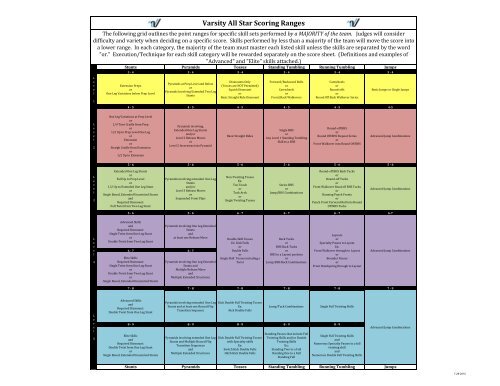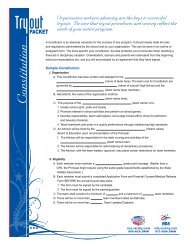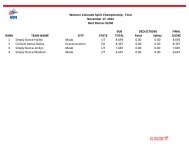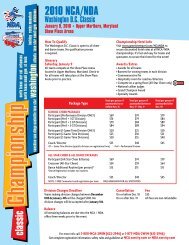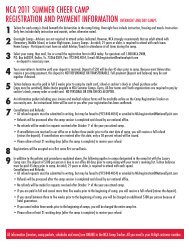Varsity All Star Scoring - NCA
Varsity All Star Scoring - NCA
Varsity All Star Scoring - NCA
Create successful ePaper yourself
Turn your PDF publications into a flip-book with our unique Google optimized e-Paper software.
L<br />
e<br />
v<br />
e<br />
l<br />
1<br />
Stunts Pyramids Tosses Standing Tumbling Running Tumbling Jumps<br />
3 4 3 4 3 4 3 4 3 4 3 4<br />
Extension Preps<br />
or<br />
One Leg Variations below Prep Level<br />
Pyramids at Prep Level and Below<br />
or<br />
Pyramids Involving Extended Two Leg<br />
Stunts<br />
<strong>Varsity</strong> <strong>All</strong> <strong>Star</strong> <strong>Scoring</strong> Ranges<br />
The following grid outlines the point ranges for specific skill sets performed by a MAJORITY of the team. Judges will consider<br />
difficulty and variety when deciding on a specific score. Skills performed by less than a majority of the team will move the score into<br />
a lower range. In each category, the majority of the team must master each listed skill unless the skills are separated by the word<br />
"or." Execution/Technique for each skill category will be rewarded separately on the score sheet. (Definitions and examples of<br />
"Advanced" and "Elite" skills attached.)<br />
Dismounts Only<br />
(Tosses are NOT Permitted)<br />
Squish Dismount<br />
or<br />
Basic Straight Ride Dismount<br />
Forward/Backward Rolls<br />
or<br />
Cartwheels<br />
or<br />
Front/Back Walkovers<br />
Cartwheels<br />
or<br />
Round‐offs<br />
or<br />
Round Off Back Walkover Series<br />
Basic Jumps or Single Jumps<br />
4 5 4 5 4 5 4 5 4 5 45<br />
L<br />
e<br />
v<br />
e<br />
l<br />
2<br />
One Leg Variations at Prep Level<br />
or<br />
1/4 Turn Cradle from Prep<br />
or<br />
1/2 Up to Prep Level One Leg<br />
or<br />
Extension<br />
or<br />
Straigh Cradle from Extension<br />
or<br />
1/2 Up to Extension<br />
Pyramids involving,<br />
Extended One Leg Stunts<br />
and/or<br />
Level 2 Release Moves<br />
or<br />
Level 2 Inversions into Pyramid<br />
Basic Straight Rides<br />
Single BHS<br />
or<br />
Any Level 1 Standing Tumbling<br />
Skill to a BHS<br />
Round‐off BHS<br />
or<br />
Round Off BHS Stepout Series<br />
or<br />
Front Walkover into Round Off BHS<br />
Advanced Jump Combinations<br />
5 6 5 6 5 6 5 6 5 6 5 6<br />
L<br />
e<br />
v<br />
e<br />
l<br />
3<br />
Extended One Leg Stunts<br />
or<br />
Full Up to Prep Level Pyramids involving extended One Leg<br />
or<br />
Stunts<br />
1/2 Up to Extended One Leg Stunt<br />
and/or<br />
or<br />
Level 3 Release Moves<br />
Single Based, Extended Unassisted Stunts<br />
or<br />
and<br />
Suspended Front Flips<br />
Required Dismount:<br />
Full Twist from Two Leg Stunt<br />
Non‐Twisting Tosses<br />
Ex:<br />
Toe Touch<br />
or<br />
Tuck Arch<br />
or<br />
Single Twisting Tosses<br />
Series BHS<br />
or<br />
Jump/BHS Combinations<br />
Round‐off BHS Back Tucks<br />
or<br />
Round‐off Tucks<br />
or<br />
Front Walkover Roud off BHS Tucks<br />
or<br />
Running Punch Fronts<br />
or<br />
Punch Front Forward Roll into Round<br />
Off BHS Tucks<br />
Advanced Jump Combinations<br />
5 6 5 6 6 7 6 7 6 7 67<br />
L<br />
e<br />
v<br />
e<br />
l<br />
4<br />
Advanced Skills<br />
and<br />
Required Dismount:<br />
Single Twist from One Leg Stunt<br />
or<br />
Double Twist from Two Leg Stunt<br />
Pyramids involving One Leg Extended<br />
Stunts<br />
and<br />
at least one Release Move<br />
6 7 6 7<br />
Elite Skills<br />
Required Dismount:<br />
Single Twist from One Leg Stunt<br />
or<br />
Double Twist from Two Leg Stunt<br />
or<br />
Single Based, Extended Unassisted Stunts<br />
Pyramids involving One Leg Extended<br />
Stunts and<br />
Multiple Release Move<br />
and<br />
Multiple Extended Structures<br />
Double Skill Tosses<br />
Ex: Kick Fulls<br />
or<br />
Double Fulls<br />
or<br />
Single Skill Tosses including a<br />
Twist<br />
Back Tucks<br />
or<br />
BHS Back Tucks<br />
or<br />
BHS to a Layout position<br />
or<br />
Jump/BHS Back Combinations<br />
Layouts<br />
or<br />
Specialty Passes to Layout<br />
Ex:<br />
Front Walkover through to Layout<br />
or<br />
Bounder Passes<br />
or<br />
Front Handspring through to Layout<br />
Advanced Jump Combinations<br />
7 8 7 8 7 8 7 8 7 8 7 9<br />
L<br />
e<br />
v<br />
e<br />
l<br />
5<br />
Advanced Skills<br />
and<br />
Required Dismount:<br />
Double Twist from One Leg Stunt<br />
Pyramids involving extended One Leg<br />
Stunts and at least one Braced Flip<br />
Transition Sequence<br />
Kick Double Full Twisting Tosses<br />
Ex:<br />
Kick Double Fulls<br />
Jump/Tuck Combinations<br />
Single Full Twisting Skills<br />
8 9 8 9 8 9 8 9 8 9<br />
Elite Skills<br />
and<br />
Required Dismount:<br />
Double Twist from One Leg Stunt<br />
or<br />
Single Based, Extended Unassisted Stunts<br />
Pyramids involving extended One Leg<br />
Stunts and Multiple Braced Flip<br />
Transition Sequences<br />
and<br />
Multiple Extended Structures<br />
Kick Double Full Twisting Tosses<br />
with Specialty skills<br />
Ex:<br />
Switch Kick Double Fulls<br />
Hitch Kick Double Fulls<br />
Standing Passes that include Full<br />
Twisting Skills and/or Double<br />
Twisting Skills<br />
Ex:<br />
Standing Two to a Full<br />
Standing One to a Full<br />
Standing Full<br />
Single Full Twisting Skills<br />
and<br />
Numerous Specialty Passes to a full<br />
twisting skill<br />
and<br />
Numerous Double Full Twisting Skills<br />
Advanced Jump Combinations<br />
Stunts Pyramids Tosses Standing Tumbling Running Tumbling Jumps<br />
7-28-2010
Stunts Pyramids Tosses Standing Tumbling Running Tumbling Jumps<br />
9 10 9 10 9 10 8 9 8 9 7 9<br />
L<br />
e<br />
v<br />
e<br />
l<br />
6<br />
Unassisted Single Based Stunts<br />
or<br />
Free Flipping Stunts to an Extended Position<br />
or<br />
Full Up Toss To An Extended Position<br />
2 and 1/2 high Collegiate Pyramids<br />
Flipping Tosses<br />
or<br />
Flipping and Twisting Tosses<br />
See 8 ‐ 9 See 8 ‐ 9 See 8 ‐ 9<br />
<strong>Varsity</strong> <strong>All</strong> <strong>Star</strong> <strong>Scoring</strong> Descriptions<br />
Maximum Difficulty will be determined by the performing team’s USASF Level. Technique will be worth an additional one point value.<br />
Technique will be evaluated on the following criteria: synchronization, form, technique, body position, flexibility and skill completion.<br />
Jumps difficulty will be evaluated based on the following criteria: variety, difficulty, incorporation, use of approaches, and quantity. Jumps execution will be based on the following<br />
criteria: chest placement, flexibility, form and landing. Basic Jumps ‐ Spread Eagle, Double Hook, Tuck and Stag. Advanced Jumps ‐ Herkie, Side Hurdler, Toe Touch, Front Hurdler,<br />
Pike and Double Nine. Combinations ‐ Connecting jumps with a prep or whip in between. Standing Tumbling difficulty will be reflected in the standing tumbling score and will not be<br />
evaluated in the jump category.<br />
Motions / Dance difficulty will be evaluated on the following three areas of criteria. Little to no transitions and level changes will score in the low portion of the range. Minimal<br />
transitions ii and dlevel lchanges to include variety of movement, footwork and dfloorwork along with ihaverage energy and entertainment value will score in the middle portion of the<br />
range. Multiple transitions and level changes to include variety of movement, footwork, floorwork along with high energy and entertainment value will score on the high end of the<br />
range.<br />
Formation / Transition difficulty will be evaluated on the following criteria: creativity, flow, visual effect, ease of movement, pace, spacing and seamless patterns. Execution /<br />
Technique will be evaluated on how well the above criteria is performed by the athletes.<br />
Performance will be evaluated on the following criteria: showmanship, energy levels, excitement, crowd appeal, uniformity, genuine enthusiasm and athletic sportsmanship.<br />
Skills Creativity will reward teams for using unique load ins, dismounts and transitions in the building and tumbling portions of the routine and will have a maximum value of 5<br />
points.<br />
Routine Creativity will reward teams for using creative and innovative choreography throughout the overall routine and will have a maximum value of 5 points.<br />
Level 4.2 teams will follow the Level 4 range for Building Skills (Stunts, Pyramids and Tosses), Overall Routine (Motions/Dance, Formations/Transitions and Performance) and the<br />
Jumps category. <strong>All</strong> Tumbling Skills (Standing Tumbling and Running Tumbling) will follow the Level 2 range.<br />
Definitions and Examples of "Advanced" and "Elite" skills<br />
Advanced Stunting Skills include<br />
Elite Stunting Skills include<br />
(but are not limited to):<br />
(but are not limited to):<br />
Extended One Leg Stunts<br />
Full Up to Extended Position<br />
Minor Releases that land at prep level or below<br />
Major Tick Tock variations<br />
Inverted transitions to Prep Level and below<br />
Inverted Transitions to an extended position<br />
Walking stunts/Turning stunts<br />
1 1/2 ‐ 2 Twisting Transitions<br />
1/2 or Single Twisting Transitions Toss Extended stunts<br />
Power Presses<br />
Release Moves that land in an extended position<br />
*Other unique Mounts and Transitions of similar difficulty level<br />
*Other unique Mounts and Transitions of similar difficulty level<br />
7-28-2010
<strong>Varsity</strong> <strong>All</strong> <strong>Star</strong><br />
Point Deduction System<br />
Bobbles<br />
Time Limit Violations<br />
Bobbles during skills will result in a .5 deduction for each occurrence.<br />
Time limit violations are as follows:<br />
3-5 seconds over time will result in a .5 deduction<br />
Examples:<br />
6-10 seconds over time will result in a 1.0 deduction<br />
-Hands down on tumbling<br />
11 or more seconds over time will result in a 2.0 deduction<br />
-Stunts and Pyramids that almost drop/fall, but are saved<br />
-Incomplete twisting cradles<br />
-Memory mistakes involving obvious execution of incorrect moves<br />
-Knee or hand touching ground during cradle or dismount<br />
-Knees touch ground in back handspring<br />
-Severe balance checks<br />
-Severe timing issues<br />
Mistakes<br />
Mistakes during skills will result in a 1.0 deduction for each occurrence.<br />
Examples:<br />
-Drops to the floor during tumbling<br />
-Drops from individual stunt to a cradle<br />
Safety Violation / Skills Performed Out Of Level<br />
Safety Violations will result in a 2.0 deduction for each occurrence.<br />
Boundary Violations<br />
<strong>All</strong> skills must originate and be completed within the competition boundary. No lineups,<br />
skills, or transitions are allowed outside of the competition boundary. Anytime a<br />
participant unintentionally steps outside the competition boundary, they must return<br />
immediately. The competition boundary is defined as the actual spring floor, the carpet<br />
bonded foam panels that connect to the spring floor, and any additional border that<br />
supports the spring floor.<br />
Excessive out of bounds is not allowed and will result in a .5 deduction for each occurrence.<br />
Excessive out of bounds includes stepping, with both feet, completely off of the<br />
-Drops from individual stunt to a pop down dismount performance mat and it's borders.<br />
(Stepping on, or just past the white tape is not a boundary violation).<br />
Falls (Major)<br />
Falls during stunting skills will result in a 1.5 deduction for each occurrence.<br />
Examples:<br />
-fall from individual i id l stunt t t to t the groundd<br />
(Top person lands on ground or multiple bases land on ground)<br />
Collapses<br />
Collapses during pyramid skills will result in a 2.0 deduction for each occurrence.<br />
-If only an individual stunt performs an error during the pyramid sequence,<br />
then only a 1.0 or 1.5 deduction will be assessed.<br />
Maximum Deduction<br />
No individual occurrence will incur more than an 2.0 deduction.<br />
Example:<br />
-If a stunt drops to the ground (1.5) and then rebuilds in the same stunt<br />
sequence and drops again (1.5), the maximum deduction issued will be a 2.0.


